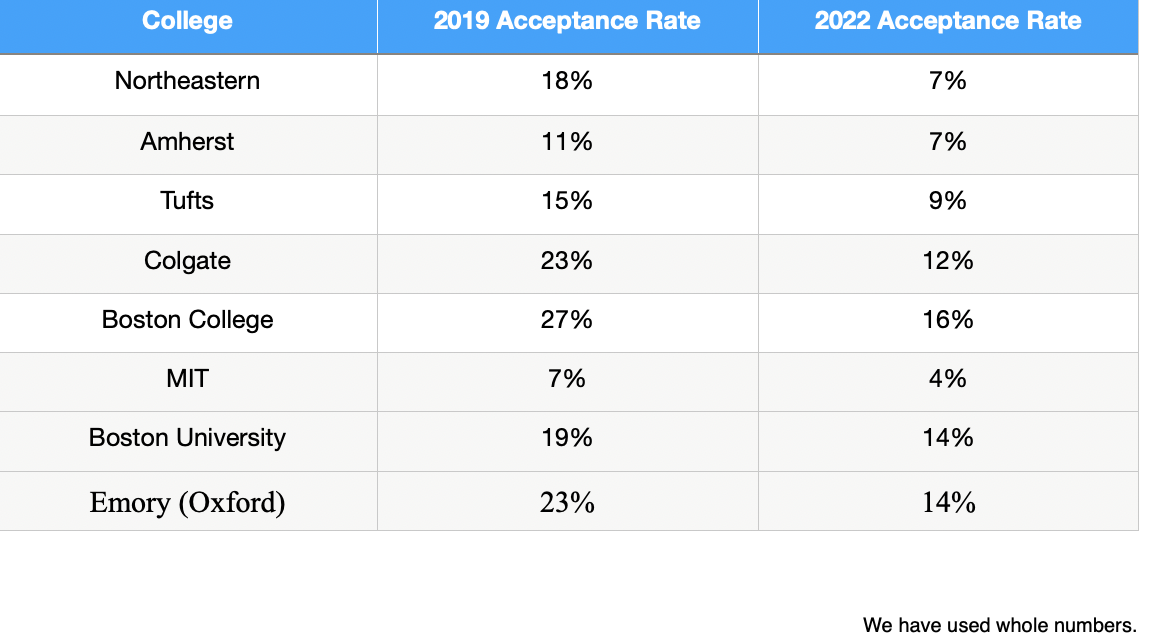Scattergrams Need to Scram
It is human nature to want to know how you stack up against others. Most students and families can not wait to get a look at their high school scattergrams. This need to compare can get so tricky that some high schools do not release scattergrams to their families. I love data and different ways to look at it, and it used to bother me that I could not see this data for specific high schools. I no longer rely on scattergrams for any information. Today families can NOT look at their high school scattergrams and see which colleges are appropriate for their child. First, for those who do not know what I am talking about, Naviance and Scoir are different software platforms high schools use to help their students with college applications. Both of these platforms provide users scattergrams for each college, which give you data on the students from their high school that have applied and been accepted, rejected, or waitlisted there in the last five years. These scattergrams look exactly like they sound, a bunch of circles scattered on a page where each student represents a certain GPA and test score.
So why are Scattergrams useless these days?
I) The college admissions landscape has changed so dramatically in the past three years that looking at who was accepted five years ago does not tell you who might be accepted today. Many selective colleges have become WAY more selective than they were pre-pandemic. Why is that?
A) For the class of 2025, the pandemic and the move to test-optional increased the number of applications at many selective colleges. Many students also took a Gap year because of the pandemic, so colleges took fewer students to the Class of 2025 to make room for the 2024s. We have covered what happened to highly selective college admissions for the class of 2025 in this past blog, but suffice it to say, many admissions rates dropped by a ton in 2025.
B) So what happened to the Class of 2026? Application numbers continued to jump up just about everywhere. The Ivies and other top-tier institutions’ acceptance rates had all fallen solidly into the single digits. This put pressure on the colleges that are one rung down in terms of selectivity, and many of those colleges have acceptance rates that also fell to the single digits. We have roughly 20 colleges in the US that now have acceptance rates in the single digits. See this past blog for some of those numbers and examples. Why did that happen?
1. The lower acceptance rates everywhere mean many colleges are also seeing higher yield rates than ever before. (The yield rate is the percentage of students a college accepts that choose to attend)
a) This is causing lower acceptance rates not just at colleges that did receive more applications but also at colleges that did not. For example, Villanova received a few hundred fewer applications than last year at just under 24,000, but they admitted slightly fewer students this year because their yield rate has risen to 32%. Many colleges talk about how their enrollment tactics change when their yield rate is higher than their acceptance rate. Villanova’s acceptance rate was 23% this year.
b) Many colleges overenrolled last year because they did not expect their yield to be as high, and many have done it again this year. This caused many colleges to become even more selective and some colleges to become highly selective that never were previously. Two examples of this would be Boston University and the University of Tampa which had a 26% acceptance rate this year compared to 54% for the Class of 2025.
II) Now that most colleges have gone test-optional, we have no idea if students submitted the test scores that appear on their Scattergrams or not.
III) Students are just dots on a Scattergram. There is no context regarding how each student fits a college's institutional priorities. These dots don’t tell us if a student is a legacy. They do not tell us if a student is a recruited athlete or if they are full-pay or full-need. Or if a student is from an underserved population. Or if a student plays the tuba and that college needed a tuba player. Please see this past blog for more on how these institutional priorities can affect college decisions often more than the students’ exact stats.
IV) Dots on a scattergram do not tell you what major a student applied to at those colleges. At most universities, specific majors are often significantly harder to get into, and students must apply directly to those programs. Nursing, Engineering, and Computer Science are some of these programs. This article is old but shows that even in 2019 before things got significantly more competitive, CS admissions were often way harder than general admissions to the same university. For example, at the University of Illinois at Urbana-Champaign in 2019, the overall acceptance rate was 62%, but the Computer Science acceptance rate was 15%.
V) Scattergrams do not tell us what kind of course rigor a student has taken. First, if the GPA is unweighted, as it is at our local high school, there is no way to tell if that dot represents the highest course rigor or no course rigor at all. Even with weighted GPAs, one can not possibly know if a future engineer has taken AP Calculus or, for that matter, if it was AP Calc AB or BC. Did the future engineer take Physics or AP Physics? The questions are endless, and the answers often determine whether a student is an admit or deny.
VI) Dots on the scattergrams can not possibly tell us what extracurricular activities a student has been involved in. At the very top universities, most of the applicants are highly qualified with excellent GPAs and test scores. It is often what a student has done outside of the classroom that distinguishes them in college admissions.
VII) Many high schools do not keep their Naviance current. They do not update individual students’ data regularly, and they even leave off some students altogether.
Naviance scattergrams do not tell you how appropriate this college is for your child. They do not even attempt to do that. They just try to tell you how hard or easy acceptance at this college might be for your child. Finding appropriate colleges for a student or, as I like to say, right fit colleges, is about helping that student figure out what they want in a college and researching to find it. Rick Clark, the Director of Admissions at Georgia Tech, just wrote a brilliant blog post where he said, Clarifying your requirements will be far more valuable than obsessing about admit rates, rankings, number of benches, or squirrel/deer to student ratio.
So while we all can’t help ourselves and want to check our high school’s scattergrams to see where that blue circle that represents you falls in the sea of dots, please try and refrain. Peering at these gives students and families false hope and heightens everyone’s anxiety. Focus instead on your wants and needs for your college experience. Scattergrams need to scram!


